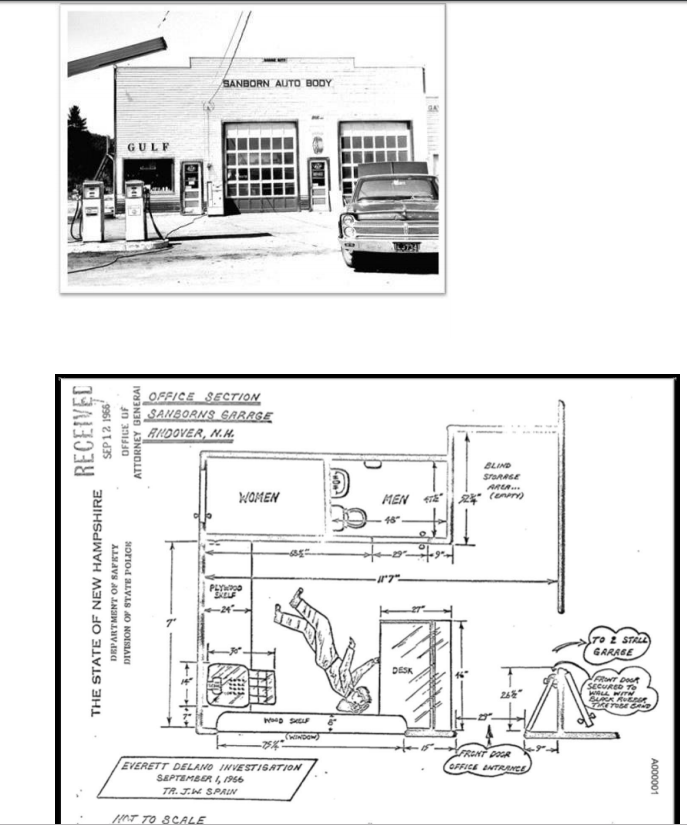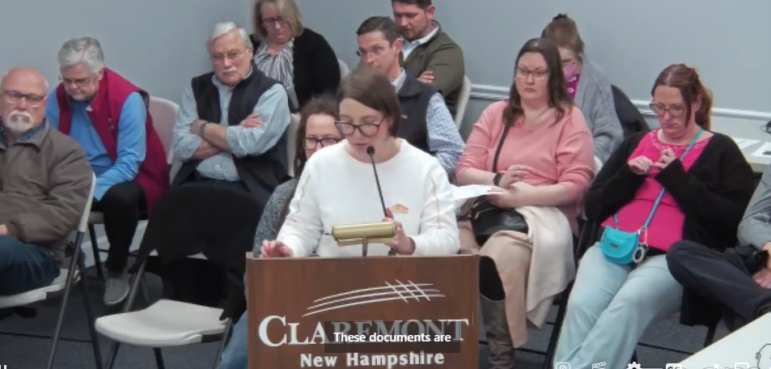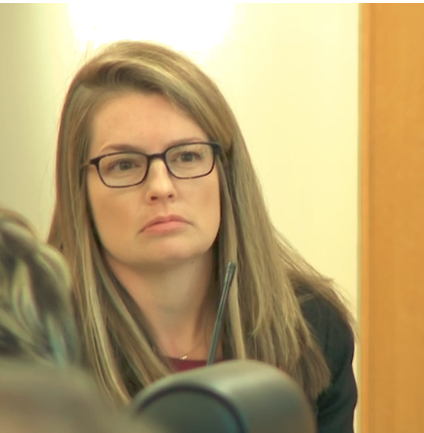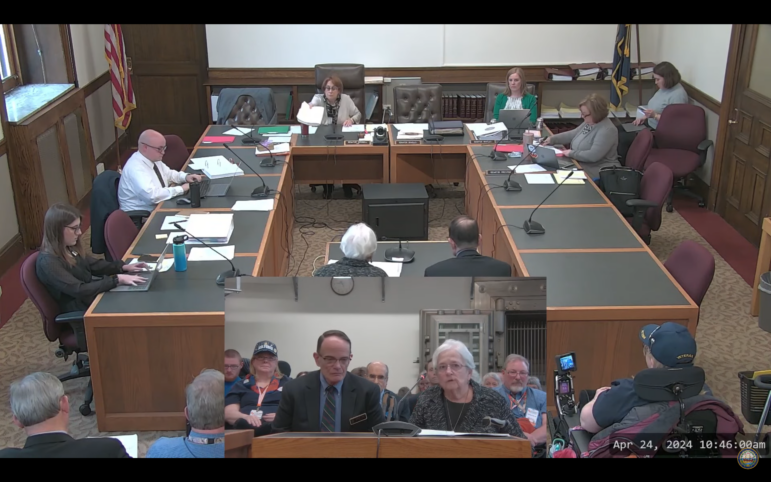Sign up for our free newsletter here.
By BOB CHAREST
He was a 49-year-old father of three living in a secluded New Hampshire town in 1966, a night watchman at Colby-Sawyer College who was found with three bullet holes in his head, still alive, on the floor of a service station.
Everett Delano, according to the teenage boys who found him on a Thursday morning, appeared to be sleeping on the floor. In fact, they said it sounded like the man was snoring. He died later at the hospital.
His murder sent shockwaves throughout the small community of Andover on Sept. 1, 1966. In fact, police rounded up guns from people within the area and did ballistics tests to determine if their .22 was the one involved. None turned out to be.
The case went cold. A family went without anyone being charged.
That is until 2013 when the family brought his case back before law enforcement.
Everett Delano, a man murdered 52 years ago, was until then another of New Hampshire’s cold cases, which number now more than a 100 in the past 40 years.
And today, due to the death of the lead suspect, his case is being closed by the Attorney General and N.H. State Police. The man police say robbed the store that morning and shot Delano – Thomas Cass, of Orleans, Vt. – ended up killing himself on Feb. 24, 2014, at the age of 67 – when he thought police were closing in on him.
The report released today reads like a crime thriller, and we include it below.
Cass had a long list of criminal activities and jail time, and he reportedly said that he wasn’t going back into a box. He also is said to have told his girlfriend, “you never talk about something that has no statute of limitations.”
Cass reportedly made his girlfriend the beneficiary of his estate, and she has, according to the report below, stated on repeated occasions that Cass never talked about the murder, even though he boasted about his other crimes.
The report follows, and we think you will find it fascinating reading.
Attorney General’s Report
Attorney General Gordon J. MacDonald and New Hampshire State Police Colonel Christopher J. Wagner, announce that the New Hampshire Cold Case Unit has solved the 1966 Homicide of Everett Delano.
Mr. Delano (age 49) was fatally shot during a robbery of Sanborn’s Garage in Andover, New Hampshire on Sept. 1, 1966.
The investigation has determined that Thomas Cass, now deceased, of Orleans, Vt., shot and killed Mr. Delano in 1966, while engaged in a robbery of Sanborn’s Garage.
INTRODUCTION: The following report is an encapsulation of the investigation of the 1966 murder of Mr. Everett Delano (49) of Andover, New Hampshire. Mr. Delano was found unconscious in the office of Sanborn’s Garage in Andover, New Hampshire on September 1, 1966. He later died from three gunshot wounds.
The initial investigation of this homicide rendered no leads identifying Mr. Delano’s killer. The New Hampshire Cold Case Unit (CCU) re-opened this investigation in 2013. CCU’s investigation uncovered evidence that Mr. Thomas Cass, of Orleans, Vermont, shot and killed Mr. Delano in 1966, while engaged in a robbery of Sanborn’s Garage. Mr. Cass killed himself on February 24, 2014, at the age 67. It is the policy of the Attorney General’s Office that homicide cases solved by the CCU, in which the suspect is deceased, are to be reported to the victim’s family and the public as closed and resolved without charges.
It is the purpose of this report to summarize the Attorney General’s findings and conclusions with regard to this homicide. The findings and conclusions set forth in this report are based on information gathered during the initial and renewed investigation, including photographs, physical and forensic evidence and witness interviews. Based upon all of the evidence gathered during the investigation into this 1966 homicide, the Attorney General finds that there is sufficient evidence to prove beyond a reasonable doubt that Mr. Cass shot and killed Mr. Delano on September 1, 1966, in Andover, New Hampshire in the course of a robbery.
Since Mr. Cass is deceased, this case is reclassified as closed and resolved without charges.
SUMMARY OF THE FACTS: On September 1, 1966, at approximately 10:00 a.m., Everett “Red” Delano (49) was found unconscious and bleeding on the floor of Sanborn’s Garage on Route 4 in Andover, New Hampshire. The New Hampshire State Police were dispatched to the scene for a possible robbery. Mr. Delano was transported to New London Hospital and then to Mary Hitchcock Hospital (now Dartmouth-Hitchcock Hospital). Initially, it was thought that Mr. Delano had been beaten in a robbery attempt.
It was later determined that he had suffered three gunshot wounds which caused his death. The New Hampshire State Police investigated Mr. Delano’s murder in 1966. That investigation included numerous witness interviews and a crime scene investigation. By the end of 1966, the investigation stalled and the case remained unsolved until the CCU renewed the investigation in 2013. The pertinent details of both the 1966 investigation and the CCU investigation are summarized below.
1966 INVESTIGATION: Witness Statements. Only statements from the individuals with relevant, first-hand knowledge of events have been outlined above.
Mr. Kenneth Sanborn the owner of Sanborn’s Garage: Kenneth Sanborn, told investigators that he had asked his friend, Mr. Delano, to watch the garage for a few hours on September 1, 1966, while he ran some errands. He stated that he left the garage around 8:50 a.m. and that Mr. Delano was pumping gas for a customer when he left.
Mr. Sanborn gave a detailed description of the money that should have been in the cash drawer that morning. Mr. Sanborn also stated that there was a register tally sheet that documented several cars had stopped for gas that morning. The money for these sales, in addition to the money that had been in the drawer at the time the garage opened, would have totaled between $75-$100. Police found that there were only pennies left in the cash drawer. However, a cash box hidden below the counter containing $500.00 was not taken in the robbery.
Mrs. Marilyn Bacon: As a result of the police requests for public assistance in this investigation, Mrs. Bacon reported to investigators that she drove by Sanborn’s Garage at approximately 9:25 a.m. on September 1, 1966.
She observed Mr. Delano in his vehicle, backing away from the gas pumps. She waved at him and he waved back.
Mr. Leon Webber: In 1966, Leon Webber (age 25) ran Camp Wilmot in Danbury, New Hampshire. He arrived at Sanborn’s Garage around 10 a.m. on September 1, 1966, with William McKee (age 16) and Pat Bruce (age unknown). Mr. Webber told investigators that upon his arrival, he encountered Ralph Lewis (age 16) and Bruce French (age 18) at the garage who told him that a man was asleep on the floor inside.
Mr. McKee and Mr. Webber entered the garage and observed blood around this man’s head. Mr. Webber then called the New Hampshire State Police and the New London Hospital. The State Police dispatch records documented his phone call to them at 10:00- 10:04 a.m. While in the garage, Mr. Webber also noticed that the water was running in the sink in the rest room. When Mrs. Sanborn arrived, she shut this water off by pulling the plug to the water pump. The records do not describe where the pump was and they are unclear why she unplugged the water pump.
Presumably, the plug for the water pump was located outside of the bathroom and she did this at the request of the police in order to maintain the integrity of the crime scene.
Mr. Ralph Lewis and Mr. Bruce French: Mr. Lewis and Mr. French told investigators that they had stopped at Sanborn’s Garage the morning of September 1, 1966, for gas. As they arrived, they saw a white vehicle parked in front of the restaurant section of the building with a dark-haired woman in the driver’s seat and a gentleman with white hair wearing a blue shirt, like a gas attendant’s shirt, in the passenger seat. As they waited for gas, the woman looked at them and shrugged her shoulders as if to say she didn’t know if anyone was at the garage.
The vehicle then left the lot. Mr. Lewis and Mr. French then went into the station. When they entered the office they thought they heard someone snoring. They found a man lying on the floor of the garage who they initially thought was drunk on the floor, but soon after they determined that he was injured. Leon Webber and William McKee then arrived at the garage. Mr. Lewis drove to the nearby Sanborn’s residence and brought Mrs. Sanborn to the garage.
Mr. & Mrs. Ralph Charles: The Charles family lived in the area of Sanborn’s Garage. They reported to police that they had heard gun shots before 8:45 a.m., but then said it may have been later in the morning. They were not concerned, however, because it was not that unusual to hear gun shots in their area.
Miss Ann Titus: Miss Titus was the telephone operator at the New London Hospital on the morning of September 1, 1966. She received the first call regarding the victim from Leon Webber at approximately 10:05 a.m.
During this call, another operator summoned Dr. Wasson. The ambulance and the State Police were then summoned to respond to the garage in Andover. The records of the New London Hospital recorded that Miss Titus called the State Police at 10:12 a.m. 7.
Mr. Merton Dean Collins: Mr. Collins was a driver for Twin State Electric Company in September of 1966. He lived in Vermont, but his driving route took him past Sanborn’s Garage at approximately 9:45 a.m. on September 1, 1966. Mr. Collins reported that he heard gunshots at the time he drove by the garage.
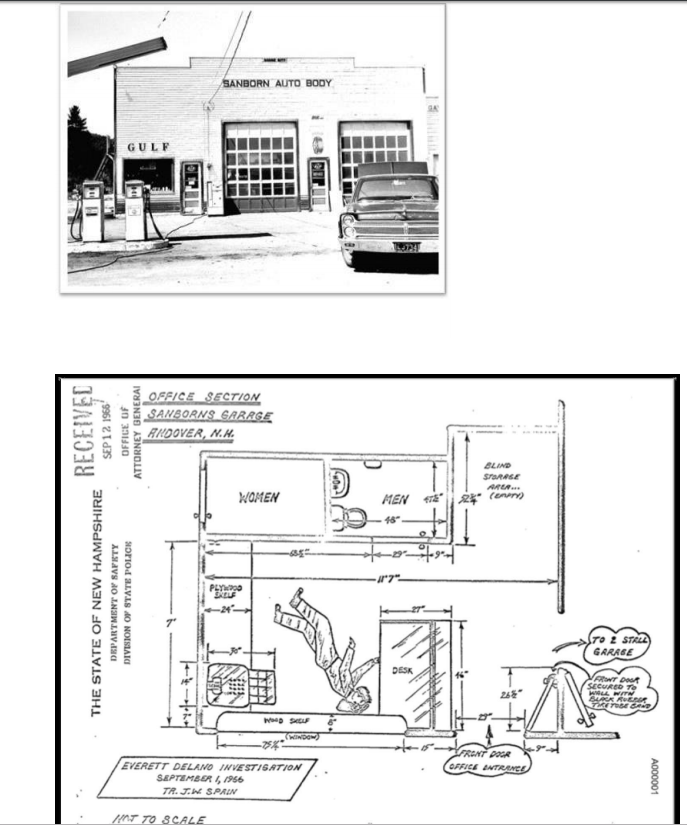
Crime Scene: The crime scene was located within the office portion of Sanborn’s Garage. Sanborn’s Garage was a small service station with a store and post office also contained within the building. The office to Sanborn’s Garage was located on the southeast side of the building. As part of the investigation, Sanborn’s Garage was diagrammed, photographed, and numerous items were taken from the office.
During the search of the office of Sanborn’s Garage, a bullet hole and a bullet were found in the clapboard near the front of the office. A .22 caliber slug was found resting in the left end of a roll top desk. However, no cartridge casings were found at the crime scene. Next to Mr. Delano’s body, was a cigarette butt that had been extinguished on the floor. This was seized for forensic testing.
The cash register and the register tape were also collected as evidence and examined. The cash drawer was found open and empty. The register receipt documented that there had been three gasoline sales since Mr. Sanborn had left Mr. Delano in charge that morning. The thief/murderer likely obtained between $75-$100 from the register. However, the cash box hidden under the counter was found intact with approximately $500 in it. In the cash register drawer the police also found a hair that was seized for forensic testing.
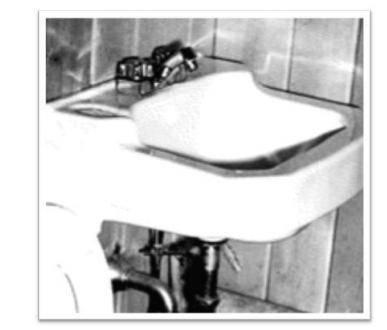
Through the information provided by Mr. Lewis, Mr. French and Mr. Webber, who had found Mr. Delano, it was concluded that the water had been running in the bathroom sink adjacent to the station’s office at the time Mr. Delano was discovered. Due to this information, the cold water faucet and soap dispenser in the bathroom were dusted for fingerprints. Several latent prints were recovered and preserved for forensic examination.
On September 7, 1966, photographs of these fingerprints were sent to the Federal Bureau of Investigations (FBI) for further examination. The bathroom sink, located next to the toilet in the diagram above. Mr. Delano’s watch was also recovered from the scene. It had been struck by a bullet and had stopped functioning at 9:35.
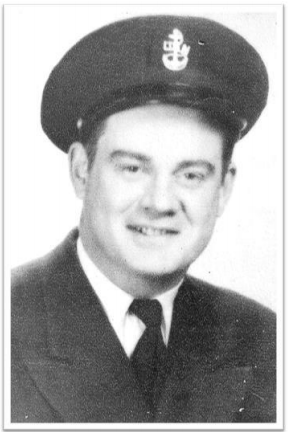
The Victim: Everett Delano Everett Delano was a 49-year old, retired naval veteran. At the time of his death, Mr. Delano was living in Wilmot Flat, New Hampshire with his wife and three children. Mr. Delano worked the overnight shift as a night watchman at Colby Sawyer College, and also worked parttime at Sanborn’s Garage. Mr. Delano died at Mary Hitchcock Hospital on September 2, 1966.
Autopsy: An autopsy was performed on Mr. Delano at the Mary Hitchcock Hospital. The cause of death was determined to be three gunshot wounds to the head. The manner of death was ruled a Homicide. The trajectory of two of the gunshot wounds indicated that Mr. Delano was in an upright position when he was shot. The third gunshot wound had evidence of gun powder residue, which is indicative of close contact with the weapon. The trajectory of this wound was consistent with Mr. Delano being shot at close range when he was on the ground.
Conclusion of 1966 Investigation: In the initial investigation dozens of interviews were conducted, but no suspects were identified. In addition, numerous .22 caliber firearms were collected from many residents in Andover and from individuals who had recently purchased a .22 caliber firearm in the vicinity. These weapons were submitted for ballistic testing, but none of the weapons had fired the bullets recovered from the scene or the victim. In addition, investigators searched the Blackwater River in Andover for a .22 caliber firearm several times, but no weapon was located. All investigative leads were exhausted by the end of 1966. The case went cold until it was reviewed by the CCU in the fall on 2013.
CCU INVESTIGATION OF THE HOMICIDE: New Forensic Testing
In the fall on 2013, the CCU investigators were contacted by a member of Mr. Delano’s family, who brought this case to their attention. This case had not been identified in the initial organization of the CCU in 2009, likely due to its age. The CCU investigators then collected the Delano homicide investigative file for review and analysis. Typically, historic cases such as this are first examined to determine if there is any evidence from the original investigation that can be analyzed using modern forensic testing.
As part of this analysis, it was discovered that the latent fingerprints collected and preserved from the bathroom sink at Sanborn’s Garage had been submitted by mail to the FBI, but they had not been entered into the Automated Fingerprint Identification System (AFIS). AFIS is a biometric identification methodology that uses digital imaging technology to obtain, store, and analyze fingerprint data collected by law enforcement nation-wide.
The AFIS database was developed over many decades, from the 1960’s to the late 1990’s, and is maintained by the FBI. In 1966, the AFIS system was not fully operational and not every state submitted fingerprint cards to the FBI. The New Hampshire State Police Forensic Laboratory began using the AFIS system in 1998. When the laboratory began using the AFIS system, they did not enter fingerprints collected in investigations prior to 1998, unless specifically requested by law enforcement.
Upon submitting the latent fingerprints from the Delano crime scene to AFIS, a match was identified. This match was then confirmed by the New Hampshire State Police Forensic Laboratory. The fingerprint collected from the cold water faucet of the bathroom sink at the Sanborn Garage in 1966 was identified as belonging to Thomas Cass.
Mr. Cass was 67 years old in the fall of 2013. CCU investigators determined that Mr. Cass was living in Orleans, Vermont in 2013. The CCU investigators also asked the New Hampshire State Police Forensic Laboratory to examine the cigarette butt found near Mr. Delano’s body at the scene and the hair taken from the cash register. The laboratory did not find any DNA in or on either item.
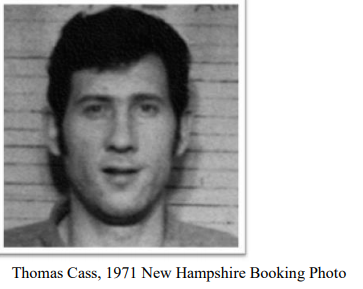
Thomas Cass – Suspect: On September 1, 1966, Mr. Cass was 20 years old. In 2013, Mr. Cass had a criminal history which spanned most of his adult life. His criminal history included numerous convictions for felonies, including robbery, armed robbery, assault, escape, use of firearms, theft and burglary. In addition to the countless other convictions which Mr. Cass amassed throughout the years, he was also convicted of a Federal drug crime.
Mr. Cass’s criminal history includes the following convictions:
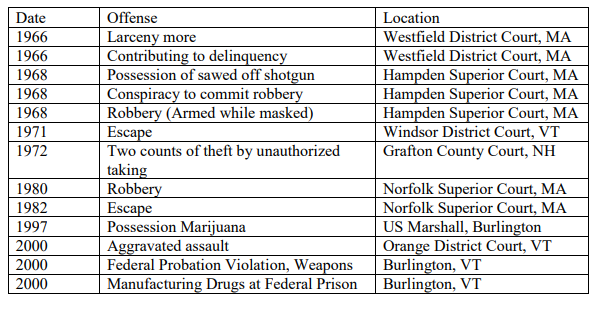
Interviews of Mr. Cass and his friends and family:
In the fall of 2013, the CCU investigators made their first contact with Mr. Cass at his home in Orleans, Vermont.
At this time, Mr. Cass was not informed of the AFIS match from the fingerprint found at the crime scene. During their interview with Mr. Cass, the CCU investigators obtained an overview of Mr. Cass’s life. He told investigators that he grew up mostly in Vermont. He said that he had joined the Army around 1963 and received a “General Discharge” in 1966.
In 1966, he moved back to Vermont and married his first wife. They soon moved to Springfield, MA, where he lived until 1967, when he was arrested for robbery. Mr. Cass acknowledged his long criminal history and confirmed that he had spent a good portion of his life in prison for his various crimes. Mr. Cass told investigators that in 1967 he committed a robbery at a gas station in Springfield, MA. During the commission of this robbery, he used a sawed-off shotgun.
He committed this robbery with two accomplices, Ray Bennett and Frank Hutchins. The three were arrested fleeing the scene. When asked if he had any knowledge of the homicide in Andover, New Hampshire in 1966, he denied having any knowledge of this and claimed he did not know where Andover, New Hampshire was located. He said that he had been in New Hampshire only once, and that was Hampton, New Hampshire.
In the same interview he acknowledged that he had once stolen a car in Vermont that he drove into New Hampshire. This conduct formed the basis of his theft convictions in Grafton County Superior Court in 1972. This arrest generated the booking photo above. In November of 2013, another meeting with Mr. Cass was arranged. During this meeting, Mr. Cass voluntary provided a sample of his DNA for the purposes of this investigation.
However, when asked, he refused to participate in a polygraph examination. Through multiple interviews with Mr. Cass’s family and friends, the CCU investigators obtained a more detailed history of Mr. Cass’s life. In an interview with one of Mr. Cass’s ex-wives, she advised that Mr. Cass grew up in an abusive family and his father was an alcoholic. When she met Mr. Cass, he portrayed himself to her as a “businessman and a crook.”
At this 10 time, Mr. Cass was working as a roadie for his friend, Myles Connor. Also during this time, she recalled that Mr. Cass entered someone’s home and terrorized the family. Mr. Cass eventually went to prison for this incident. She told the CCU investigators that Mr. Cass was a very violent person and on multiple occasions he had threatened her life. She obtained a restraining order against Mr. Cass and then divorced him.
She stated that he was proud of his past criminal career and would boast about it. She believed that he would hurt people to get what he needed. Another of Mr. Cass’s ex-wives reported that she overheard a conversation with some of her husband’s associates in which they were bragging about a homicide they got away with in the 1970’s of a young woman who they claimed “knew too much.”
The ex-wife reported that in a separate incident she had witnessed Mr. Cass leave their home with a gun to retaliate against someone who owed him money. She also witnessed the aftermath of a brutal beating Mr. Cass inflicted someone who owed him money. That individual was treated at a local hospital and released. She also described an incident in which Mr. Cass beat an individual with the butt of his gun.
She told investigators that she had known Mr. Cass over the years to own multiple firearms. On Thursday, February 20, 2014, the CCU investigators again went to Mr. Cass’s residence, but this time they went unannounced. The CCU investigators explained to Mr. Cass that forensic evidence had been found at the gas station in Andover, New Hampshire that directly linked him to the murder of Mr. Delano.

Mr. Cass continued to deny that he had ever been at or in the gas station. He was confronted with the fact that the forensic evidence collected in this case put him in the gas station at the time of the robbery and subsequent homicide. However, Mr. Cass was not told what forensic evidence had been found linking him to this crime. Mr. Cass stated several times that to the best of his knowledge he had never been to Sanborn’s Garage.
He then said that did not remember being at the gas station. He explained that his regular driving route from Massachusetts to Vermont did not take him into Andover, or past this gas station. He then said that it was possible that he went by Sanborn’s Garage and that he got gas there, but that he did not know when that would have been.
When offered the opportunity to give his explanation of events, Mr. Cass requested a lawyer and the interview was terminated. Immediately following the interview, a search warrant was executed by the Vermont State Police at Mr. Cass’s residence in an effort to locate the weapon used in the 1966 homicide of Mr. Delano. No weapons were found on the property. However, it is noteworthy that a judge made a determination from the evidence noted above that there was probable cause to believe that evidence of Mr. Delano’s murder, specifically the murder weapon, might be found at Mr. Cass’s residence.
Four days later, on Monday, February 24, 2014, the CCU investigators were notified by the Vermont State Police that a 911 call had been received from Mr. Cass’s residence reporting that Mr. Cass had committed suicide. Mr. Cass died of a self-inflicted gunshot wound to the right side of his head.
A Llama .45 caliber handgun was found near his body. On February 24, 2014, CCU investigators spoke with Mr. Cass’s live-in companion, Jane Spainol. Ms. Spainol stated that Mr. Cass never told her anything about the homicide investigation and that he had not acted out of the ordinary after the investigators left four days earlier.
She had, however, noticed him with a large amount of cash a few days earlier and 11 suspected that he had used this to purchase the firearm that he had used to kill himself. Ms. Spainol also told investigators that after their first visit in October of 2013, Mr. Cass had changed his will to make her the beneficiary of his estate. CCU investigators later identified the person who sold Mr. Cass the weapon the weekend before his suicide.
This was a private sale conducted by a friend of Mr. Cass. This individual did not know why Mr. Cass wanted the weapon or that he intended to use the weapon to take his own life. Following Mr. Cass’s suicide, CCU investigators obtained a copy of the 911 call made by Ms. Spainol on the morning of Mr. Cass’s suicide.
In her 911 call, Ms. Spainol reported that Mr. Cass believed that the police were coming to arrest him in relation to a cold case investigation. In a follow up interview conducted by the Vermont State Police regarding the suicide, Ms. Spainol said that Mr. Cass believed that the New Hampshire State Police were coming that day to arrest him.
She also told the Vermont State Police that after the CCU investigators visited him in October of 2013, Mr. Cass had seen a lawyer regarding a will and a power of attorney. She reported that Mr. Cass had told her that he had never been to Andover and that he was not involved in the murder. However, Mr. Cass had also once told her in the past, “you never talk about something that has no statute of limitations.” She also told investigators that in the past Mr. Cass had made comments about never going back to prison. He told her that he would not die in a square box.
Through the continuation of the investigation, it was documented that several individuals knew that Mr. Cass had changed his will to make Ms. Spainol the beneficiary of his estate after the initial contacts by CCU investigators. In addition, Ms. Spainol told the CCU investigators and one of Cass’s friends, that Mr. Cass had spoken to a lawyer regarding representation for the homicide investigation. CCU investigators also spoke with Mr. Cass’s sister following his death. She said that she had received a call from Ms. Spaniol suggesting that if she wanted to see her brother, she needed to visit promptly because he was going to be arrested in the near future.
The sister told CCU investigators that she believed that this meant he was going to commit suicide, because the last time he got out of prison he told her that he would never go back. In November of 2018, Ms. Spainol was located in Kentucky. She was re-interviewed regarding this case by members of the Kentucky State Police at the request of the CCU investigators. In that interview, she re-iterated that Mr. Cass had never made any admissions to her or told her anything that would incriminate him in Mr. Delano’s murder.
APPLICABLE LAW AND LEGAL STANDARDS: New Hampshire’s current homicide laws are set forth in RSA Chapter 630. However, in 1966, New Hampshire’s criminal code had not yet been codified. The applicable statute at the time was RSA 585:1, entitled “Degrees.” The statute provided, “[A]ll murder committed by poison, starving, torture or other deliberate and premeditated killing, or committed in perpetrating or attempting to perpetrate arson, kidnaping, rape, robbery, or burglary, is murder of the first degree; and all murder not of the first degree is of the second degree.” RSA 585:1 (1955 Revised Statutes Annotated).
The New Hampshire Supreme Court in State v. Greenleaf, 71 N.H. 12 606, 54 A. 38 (1902) explained the elements of the offense of first degree murder set forth in RSA 585:1 (1955) as follows: to warrant conviction of murder in the first degree, the state must show beyond a reasonable doubt not only killing with malice, but must go further, and show that the killing was deliberate and premeditated, unless done in perpetrating or attempting to perpetrate one of the collateral felonies named in the statute. Id. 54 A. at 42.
This version of the crime of first degree murder is essentially the same as set forth in the current first degree murder statute, RSA 630:1-a. The applicable provision of the current law defines one variant of first degree murder as the following conduct; the defendant causes the death of another knowingly, while engaged in the commission of a robbery while armed with a deadly weapon, the death being caused by the use of such weapon. RSA 630:1- a,I(b)(2).
The facts in this case are clear that Mr. Delano was shot and killed during the course of a robbery. Given the fact that Mr. Delano was shot three times, including once at close range when he was on the ground, the evidence establishes beyond a reasonable doubt that the murderer acted knowingly and arguably with premeditation and deliberation. In addition to the evidence that Mr. Cass’s fingerprint was at the scene, there is evidence in this case that Mr. Cass made admissions of guilt as discussed below.
Mr. Cass’s suicide is one of those admissions of guilt, which would be considered evidence of his consciousness of guilt. The Courts have admitted a variety of evidence that is considered “consciousness of guilt” for the jury to consider as evidence of guilt. See, State v. Evans, 150 N.H. 416 (2003) (false exculpatory statements constitute circumstantial evidence of consciousness of guilt); State v. Russell, 159 N.H. 475, 488 (2009) (threats against witnesses can be considered as evidence of guilt).
It is most common to request a jury instruction that evidence of a defendant’s flight from the police can be considered by the jury as evidence of both feelings of guilt and actual guilt. N.H. Criminal Jury Instruction, 1.19. In State v. Brown, 128 N.H. 606 (1986), the Court equated an attempted suicide with evidence of flight. The Court held, “[j]ust as a jury may consider flight after a crime as showing consciousness of guilt, it may also consider attempted suicide, as an attempt to flee and escape forever from the temporal consequences of one’s misdeed.” Id. at 616. (quotations and citations omitted) Similarly, in this case, Mr. Cass’s suicide can be considered evidence of his guilt.
ANALYSIS: The only reasonable conclusion that can be drawn from the discovery of Mr. Cass’s fingerprint on the running water faucet at Sanborn’s Garage is that Mr. Cass was at the Garage on September 1, 1966. The investigation did not uncover any innocent explanation for the discovery of Mr. Cass’s fingerprint at that location on that date.
His repeated and adamant denials that he had ever been at the garage or that he even knew the location of Andover, New Hampshire, is in direct contradiction to this highly inculpatory forensic evidence. Thus, it is reasonable to infer that he was involved in the robbery of the garage and the murder of Mr. Delano. It is also reasonable to infer from the existence of that fingerprint that he lied to investigators to conceal his crimes, including the crime of murder, which has no statute of limitations.
The evidence of his fingerprint at the crime scene was sufficiently persuasive for a judge to issue a warrant to search Mr. Cass’s home in Vermont in 2014, for the murder weapon used in 1966. In addition to the fact that his fingerprint was on the running water faucet at Sanborn’s Garage on the day of Mr. Delano’s murder, Mr. Cass did two things that are arguably admissions of guilt.
First, Mr. Cass said to his companion, Ms. Spaniol that, “you never talk about something that has no statute of limitations,” after he was interviewed by the CCU investigators. This statement is arguably an admission of guilt. The only crime for which there is no statute of limitations is homicide and he obviously knew that. See, RSA 625:8, II (2016). The law was the same in 1966. See, RSA 603:1 (1955). Furthermore, he made this statement after he had been accused of killing Mr. Delano and after telling Ms. Spaniol that he was not involved in the crime.
If Mr. Cass had not killed Mr. Delano, he would have no reason not to talk about it, regardless of the statute of limitations. The second admission of guilt is his suicide. Mr. Cass believed that he was going to be arrested and charged with murder in the four days between his last interview with CCU investigators and the day of his suicide. Over the years, he had made it clear to those closest to him that he would never go back to prison.
It is a fair inference that he killed himself to avoid going back to prison. As discussed above, this conduct arguably reflects his consciousness of guilt, in that it suggests that he did not believe that he could defend himself against the murder charge and that he was escaping forever from the consequences of this murder.
While he was never told about the fingerprint, he did know that he had provided a DNA sample in November of 2013, and a few months later the CCU investigators returned and told him that they had forensic evidence placing him at the scene of the murder. It is reasonable to conclude that this information caused him to believe that he would not be able to defend himself against the murder charges, and if arrested, he would spend the remainder of his life in prison.
Finally, while much of Mr. Cass’s extensive and violent criminal history would not be admissible at a trial to establish that he killed Mr. Delano; this history does reflect that he had committed similar crimes during his life, such as robbery and felonious use of a firearm. These convictions provide reliable evidence to use in our assessment that it would not have been out of character for Mr. Cass to have committed the robbery of Sanborn’s Garage and to have murdered Mr. Delano in the course of that robbery.
CONCLUSION: The evidence derived from this investigation, and all of the reasonable inferences that can be taken from that evidence, establish beyond a reasonable doubt that Mr. Cass shot and killed Mr. Delano on September 1, 1966, during the course of a robbery at Sanborn’s Garage in Andover, New Hampshire. Since Mr. Cass is deceased, and some of the evidence against him is the inference of guilt from his suicide, this case cannot be resolved with criminal charges. In lieu of criminal charges, this case will now be administratively closed and resolved without charges. This previously unsolved homicide is now solved.
While he was never told about the fingerprint, he did know that he had provided a DNA sample in November of 2013, and a few months later the CCU investigators returned and told him that they had forensic evidence placing him at the scene of the murder. It is reasonable to conclude that this information caused him to believe that he would not be able to defend himself against the murder charges, and if arrested, he would spend the remainder of his life in prison.
Finally, while much of Mr. Cass’s extensive and violent criminal history would not be admissible at a trial to establish that he killed Mr. Delano; this history does reflect that he had committed similar crimes during his life, such as robbery and felonious use of a firearm.
These convictions provide reliable evidence to use in our assessment that it would not have been out of character for Mr. Cass to have committed the robbery of Sanborn’s Garage and to have murdered Mr. Delano in the course of that robbery.
